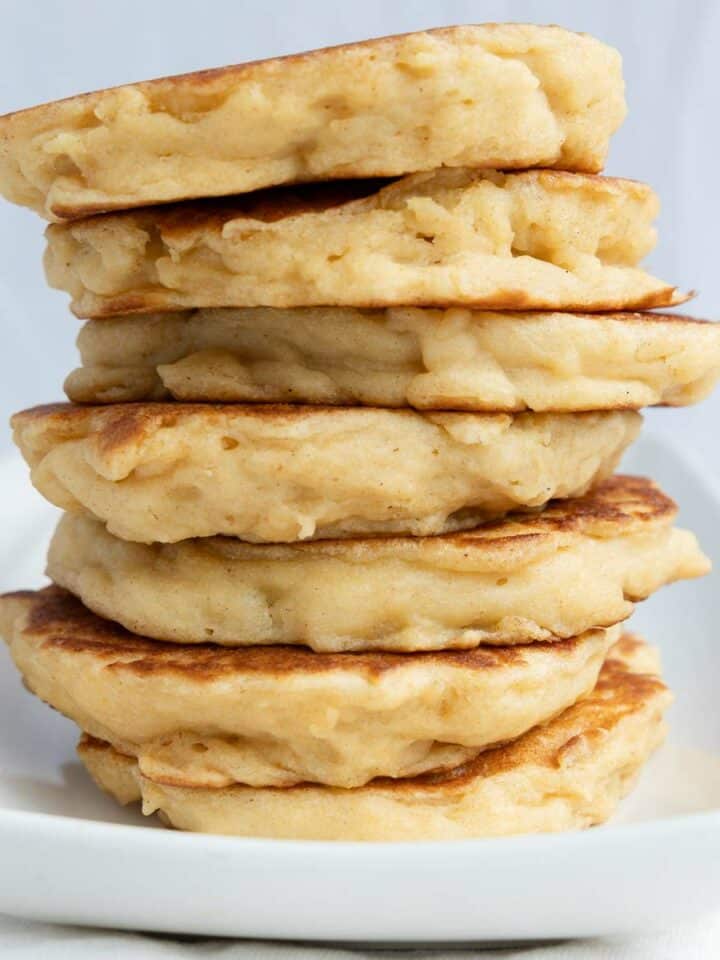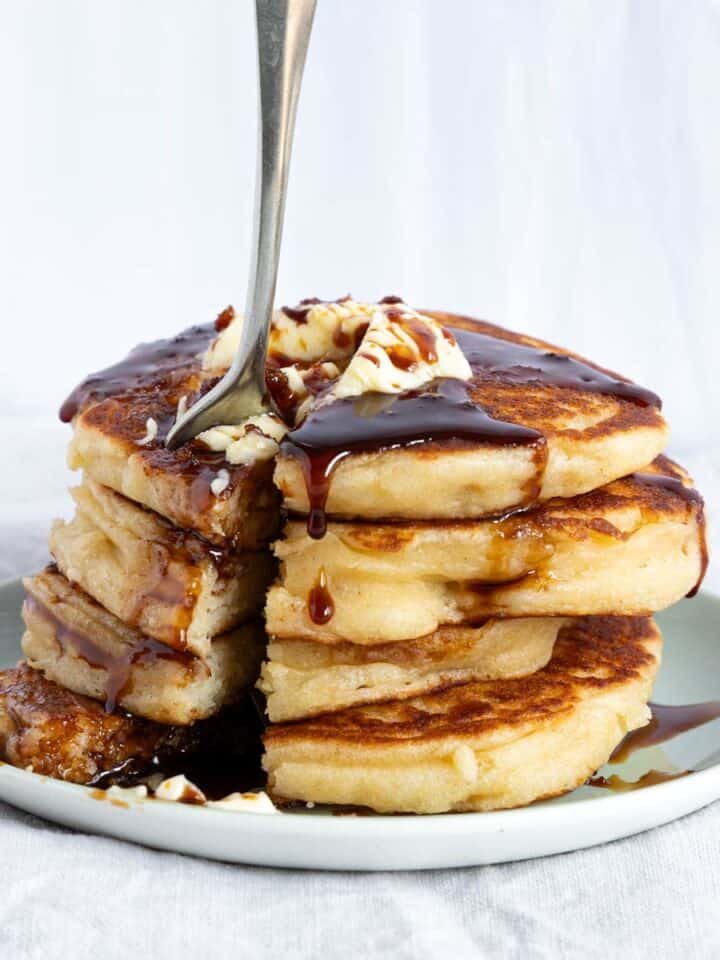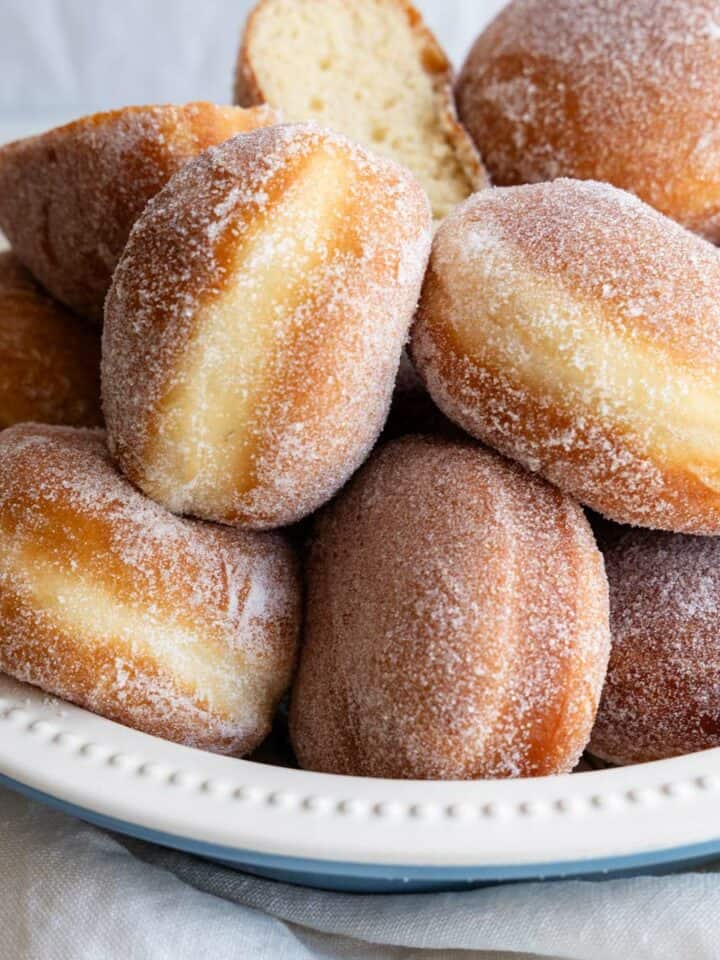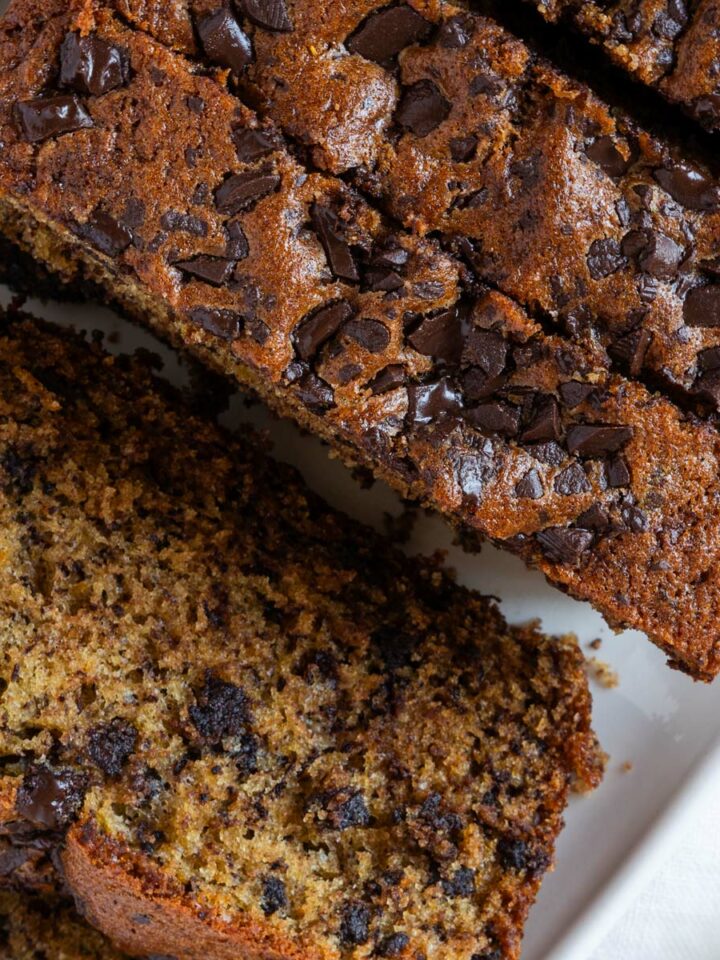
We tested James Martin Yorkshire puddings to find out if it's the perfect reliable recipe for this popular English side dish, and our experiment was full of surprises.
⏳ 25 Minutes Baking Time
👪 12 Pieces
🍎 120kcal/pc
Bookmarks
- ❓ Which James Martin Yorkshire pudding recipe to choose?
- ⚖️ How do the ingredient ratios affect the Yorkshire pudding?
- ⌛ Does it help to rest the batter overnight?
- 🌡️ How does the oven temperature affects the Yorkshire pudding?
- 🧊 What happens if the oil isn't hot enough for Yorkshire puddings?
- Final thoughts
- Frequently Asked Questions
- 📷 See How It's Made
- James Martin Yorkshire Puddings
I still remember eating my first Yorkshire pudding as a part of a Sunday roast that I ordered in a pub. I had no clue what to expect (in Czechia, ‘pudding’ is a sweet custard dessert), but the well-puffed batter dipped in savoury gravy won my heart.
This experience set me on a mission, and I wanted to re-recreate the authentic-looking Yorkies shaped like a cup with perfect crisp texture on the outside while still light and soft inside.
But as always, I realised that not all recipes are equal. While the ingredients are simple, the flaw is often in their wrong ratios or inaccurate method.
Considering my positive experience with James Martin's recipes in the past, I was eager to test his Yorkshire puddings. I had high expectations and the test prove to be an enlightening experience that came along with a few surprises.
❓ Which James Martin Yorkshire pudding recipe to choose?
I initially found two Yorkshire pudding recipes by James Martin on Google, both available from the BBC website (among other places).
One requires 8 eggs and the other 3 eggs, but the substantial difference between the two recipes is the ingredient ratios.
Here is the comparison of the ingredients per an egg for both recipes:
- Recipe with 8 eggs: 1 egg / 28.12g flour / 75ml milk
- Recipe with 3 eggs: 1 egg / 66.66g flour / 100ml milk
As you can see, the 8-egg Yorkshire pudding contains less milk and half the flour per egg. That means it has a higher concentration of egg than the other recipe.
Fast forward to the result, we liked the 3-egg recipe better. It seems odd because the other recipe happens to be more popular, but we were united in our decision.
And what made us favour the 3-egg Yorkshire pudding recipe?

⚖️ How do the ingredient ratios affect the Yorkshire pudding?
The main reason for my first test was to compare the two of James Martin's recipes and find out how the different ratios of flour, milk, and eggs affect the texture and rise.
I prepared two different batters precisely following the instructions, rested them overnight in the fridge (read my other experiment about the resting time), and baked them side-by-side in the oven preheated to 220C (fan setting).
Result
8-egg recipe:
- significant rise (however, these Yorkies always shrank once out of the oven, even though they were well browned)
- large and very uneven
- the outer skin was relatively soft with small blisters
- the texture was light and airy but almost paper-like around the edges
- tasted eggier
- these Yorkies were browning faster than the other recipe


3-egg recipe:
- more even, uniform shape
- slightly lower rise (but still very good)
- the skin was firmer
- they held their shape better than the other Yorkies
- soft inside and crisp on the outside
- nicer texture to bite


Conclusion
We prefer Yorkshire puddings made from the 3-egg recipe mainly for their texture and look. They also have a firmer outer skin that sets more crispy, preventing the puddings from deflating once out of the oven.
Note: The 8-egg recipe is identical to the batter for James Martin's toad in the hole from the ITV website that we wrote about in one of our previous posts.
We definitely recommend the 8-egg recipe as the best choice for a large oven tray/dish, but how ever-surprising it might be, we believe that the 3-egg mix ratios are better suited for making individual Yorkshire puddings using a tin with muffin or cupcake size slots.


⌛ Does it help to rest the batter overnight?
James Martin can be very particular about resting the batter overnight, as he mentioned during his This Morning presentation on ITV.
I understand that resting time should improve the Yorkshire pudding taste and help them to rise better. To test it, I cooked the next batch of Yorkshire puddings from the overnight rested batter and compared them to the Yorkshire puddings made from a batter I set aside for only 30 minutes.
Result
Overnight rested batter (right) seemed to have a wee bit more rising power, but there wasn't any major difference (as long as we could tell) in the flavour of the two versions.

Conclusion
I didn't see any greater benefit the overnight resting would bring to my Yorkshire puddings, therefore I won't follow James Martin's advice to prepare the batter a day ahead.
Tip: Check my next experiment with the oven temperature if the volume is what you are after.
🌡️ How does the oven temperature affects the Yorkshire pudding?
Typically, the instructions for making Yorkshire puddings highlight how important it is to preheat the oven well, but the recommended temperature between recipes can vary.
I decided to try two very different oven temperatures (using an intense fan setting):
- 180C (following the 3-egg James Martin's recipe)
- preheated oven to 250C, and the temperature reduced to 220C once the batter is in the oven (inspired by Christopher Blackburn's award-winning Yorkies)
Result
The difference was astonishing. The very high oven temperature (preheated to 250C and turned down to 220C) made the most uniform-looking Yorkshire puddings; on the other hand, making Yorkies at 180C caused them to rise into giant puffed monsters.
Yorkshire puddings baked in the oven preheated to 250C



Yorkshire puddings baked with at 180C



Conclusion
The oven temperature can significantly affect the Yorkshire pudding's appearance and the way they rise.
If you want humongous Yorkies and are not bothered about their uneven shape, stick with the lower temperature around 200C/ fan 180C and fill the moulds more than halfway up.
Note: Don't set the temperature any lower otherwise, you are risking the opposite - the batter not expanding at all.
If the uniform look is the goal then try the high temperature with the oven preheated to 250C, and reduced to 220C once you put the tray with the batter in. I had the best result when I filled the moulds only ½ way.
🧊 What happens if the oil isn't hot enough for Yorkshire puddings?
You might be astounded by this one, but not having the oil hot before pouring the batter in isn't a huge error. I was able to make perfect Yorkies without preheating the oil as long as the oven was sufficiently hot.
I poured the batter into a non-preheated tray with non-preheated oil and inserted the tray into a 250 C preheated oven. You can see from the pictures below my Yorkshire puddings rose just fine.



They didn't expand dramatically but it's not always a bad thing as these puds looked more uniform.
Note: It works the best if you use a thin metal tray with a good quality non-stick coating, because without preheating the oil, the puddings are more likely to stick to the tray, making it difficult to release them.
Final thoughts
If you are unsure which James Martin's Yorkshire pudding recipe to choose, I can highly recommend the one that asks for 3 eggs. It works great for a tray with deep muffin slots that I like to use.
I've started skipping the overnight resting time as I didn't find it as important during testing. Instead, I pay more attention to the oven temperature as it's crucial to controlling the Yorkshire pudding rise.
Setting the oven to a high temperature helps to make more uniform puddings, but because the batter sets faster the pudding grows slightly less. I sometimes chose to make bigger Yorkshire puddings while other times I go for a more uniform appearance.
I still preheat the oil before pouring the batter in however, I'm more relaxed about it now and don't rush it the same way as I did before. It makes the step safer as I used to burn my fingers and spilled the batter in an attempt to move the filled tray back to the oven as quickly as possible.
Frequently Asked Questions
Yes, you can make the batter for Yorkshire pudding a day ahead. James Martin even urges you to do so and claims that well-rested batter makes better puddings.
Yorkshire pudding doesn't need any raising agent. The steam trapped in the batter during baking makes the Yorkshire pudding expand. It is crucial to have the oven preheated to a high temperature to be able to generate enough steam. Not having the oven hot enough is the most common reason for flat Yorkshire puddings.
Don't worry to leave the puddings in the oven until they have a dark golden brown colour. This way the batter has enough time to rise and the edges crispen, which prevents shrinking.
Note: Looking through the oven glass makes them look darker than they are, be patient and wait. Opening the door and looking at them can make them deflate due to the decrease in the temperature.
Baked and cooled Yorkshire pudding can be frozen to be defrosted once you need them.
Yes, reheated Yorkshire pudding can be as good as freshly baked.
For the best result, reheat your Yorkshire puddings in the preheated oven to 200C/ fan 180C for 1.5 to 2 minutes.
Yorkies are a versatile side dish that pairs exceptionally well with any meal with gravy or sauce - vegetable or meat-based. The smaller puds can sit on the side of the plate while the large Yorkies can be filled with food including meat, gravy and mash.
In the UK the traditional way to rock the Yorkshire pudding is to serve it with a smashing Sunday roast.
Yorkshire pudding can make a fantastic dessert. Try the old-school combination of sugar and jam or make our Yorkshire pudding profiteroles (coming soon) for an ultimate sweet experience.
No. The main ingredients for a regular Yorkshire pudding are eggs and milk.
To make the recipe vegan you would need to substitute eggs and swap milk for a dairy-free alternative. You can check out this highly rated Yorkshire pudding recipe by A Virtual Vegan.
No, because Yorkshire pudding recipes normally include plain (all-purpose) flour, which contains gluten.
To make your Yorkshire puddings gluten-free, replace the plain flour in James Martin's recipe with a Dove's Farm gluten-free bread flour and arrowroot flour mixed 1:1.
Did you know that Yorkshire pudding is so popular in the UK it even got its celebration day? It happens to be every year on the first Sunday in February.
📷 See How It's Made
James Martin Yorkshire Puddings
Ingredients
- 200 g plain flour
- 3 eggs
- 300 ml milk
- 1 pinch salt
- oil or lard to grease the tray
Equipment
- mixing bowl
- Hand whisk or electric whisk
- Yorkshire pudding tray I like using a muffin tray with deep slots, each with a diameter of 6.5 centimetres.
Instructions
- Sift the plain flour into a large mixing bowl and season with salt. Crack the eggs into the flour. Gradually whisk the milk with the flour and eggs until you create a smooth batter - the consistency of double cream.
- Let the batter rest in the fridge for 30 minutes. Note: It's safe to make the batter ahead and leave it in the fridge overnight, but it's not essential.
- Heat the oven to 220C / intense fan 180C. Tip: If you want to make more uniform Yorkies, use a higher temperature. Preheat the oven to 250C (intense fan setting), turning the temperature down to 220C once the batter is in (reduce the baking time to 18 - 20 minutes).
- Fill each slot of the tray with ½ teaspoon of oil and heat it in the oven for 5 minutes or until smoking hot.
- Pour the batter into the tray (I fill the individual slots ½ to ⅔ way up). Bake for 25 - 30 minutes or until the Yorkshire puddings are dark golden brown. Tip: The Yorkies will hold their shape better if their skin is crisp and well baked. Don't remove them too soon. Note: This 3-egg recipe makes a generous amount of batter. You will likely make more than 12 pieces depending on the tray size and how much you fill it.






Leave a Reply